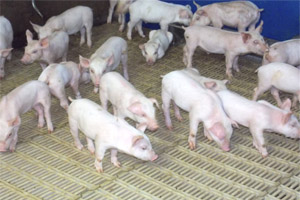Feeding porridge to increase weight in piglets

The increased litter size in modern sows means that pig producers invariably have to face a high percentage of uneven and lightweight piglets which have a poor appetite after weaning, remain small and do not grow as fast as their potential, says Dr. Viorica Popa of Bocm Pauls International.
The feeding programme for baby pigs has a direct effect on gut development and affects the performance of the pigs. Each 10g/day extra daily liveweight gain, immediately after weaning, results in 1kg extra liveweight at the end of the production cycle. The aim should be to increase feed intake especially in the first two weeks after weaning.
For piglets weaned at a very early age, or for lightweight piglets, Bocm Pauls has adopted a special feeding programme based on their Supreme Choice ration fed as a ‘porridge’ via new electronic feeders. The diet is specially designed to support and stimulate optimum development of the piglet’s gut through a unique balance of high quality ingredients.
The programme offers a nutritious and simple solution to the problem of feeding very young and small piglets (from 4-4.5 kg. liveweight). The diet can help ease the change from sow’s milk to solid/semi solid feed for several reasons:
Piglets are more familiar with the presentation of the feed
- Piglets do not have to learn to balance their dry feed intake with water from a drinker as quickly
- The feeders can be programmed to provide feed in a similar manner to the sow’s milk let down i.e. small amounts every hour. This reduces the risk of over-eating and E.coli scours
- Avoidance of dehydration helps achieve a high daily intake of feed
- The warm porridge provides a more suitable medium to enhance the effect of enzymes added to aid digestion in the small piglets.
- Less wastage of feed and water.
The porridge feeding system was introduced on to a newly renovated rearing unit with refurbished buildings and new stock. Some of the newly arrived piglets were seen to be very variable in size and underweight at weaning. This should not be the case with new stock housed in new buildings on a liquid feeding system. It was decided to move the underweight piglets (under 4.5 kg) into a nursery and put on a diet of Supreme Choice fed through a Quality Equipment transition feeder. The formulation of the diet comprised ingredients easily digested by young pigs and is presented as a warm porridge.
Feed in this form during the post weaning period has an important influence on voluntary feed intake. The soft consistency of the warm porridge and the noise the piglets make during consumption is associated with the sound of suckling on the sow. This and a special signal from the feeder attracts other piglets and stimulates feed intake. From a nutritional point of view, the more often warm porridge is fed in small amounts during the day, the better. Feeding time remains stable at thirty minutes per hour to stimulate the intake of dry food.
In a trial, involving a total of 143 piglets on the 850-sow unit run by Ioan Szabo and Melinda Szekeres at Band, Mures County, Romania, the control group were fed dry Bocm Pauls Vitostart pellets. In the other groups the piglets received Supreme Choice feed in porridge form on a little and often basis then moving to choice feeding, with dry Vitostart pellets being introduced.
In groups 1-4 the piglets began to eat the porridge feed immediately while those in the control group needed an acclimatisation period of approximately 1.5 days to eat the same amount of feed as the piglets on the feeder. Average growth rate of the pigs on porridge was 244 grammes/day compared with 197 grammes/day for those fed dry pellets. The piglets’ behaviour was observed during the trial. Those on the porridge diet were more restful and less aggressive than the dry fed piglets.
The results of the trial showed that when lightweight piglets can be housed separately in the nursery and fed warm porridge, they will show a good response in terms of liveweight gain and the incidence of infections and scouring will be decreased. “While many pig farmers will be well aware of this approach to feeding baby pigs, there are still those who have not adopted the system and are therefore not fully exploiting the potential of their piglets with a negative effect on financial returns,” comments Tony Suckling, International Director, Bocm Pauls.











